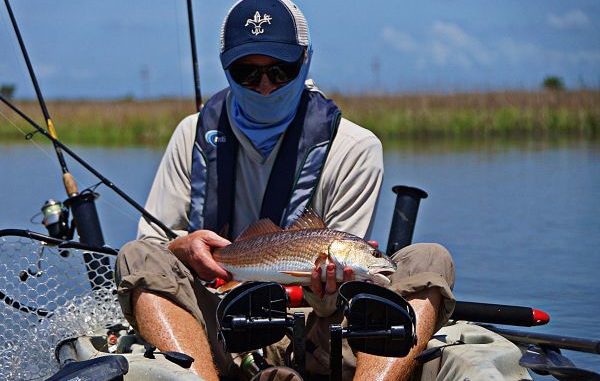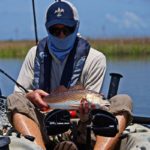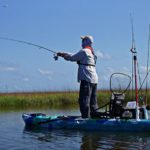
’Yak fishing still possible during windy March
Spring is on its way. The longer, warmer days are certainly welcomed by kayak anglers, but the wind — not so much.
March is generally the windiest month of the year. That’s a scientific fact caused by the clash between an increase in warm fronts that tangle with the remaining cold fronts. The difference in pressure causes strong winds as air circulates between the two.
But with a little preplanning, good fishing can comfortably be found even on some of the windiest days.
Rather than setting out blindly and just getting blown from spot to spot, methodically planning routes and strategic points of interest maximizes the chances of success.
Get a good aerial map or use Google Earth to see a broad overview of the area surrounding your intended launch point. Look at it from all angles to see which routes to take depending on the day’s prevailing wind.
To lessen fatigue, I like to start my trip going into the wind. This takes advantage of fresh muscles and excited anticipation. The idea is to fish in this general direction for about half the distance of your intended trip.
Then, even if the wind gets stronger, fishing your way back to the launch will be much less strenuous.
The water temps in March have begun to rise and the fish will get a bit more active. However, this also spreads them out, and you might not find them piled into one spot as in the fall or winter.
Bait is also scattered and scarce during this transition time, so key in on any signs of bait or water disturbance.
Carrying the map with you or having good mapping software on your GPS or phone allows you to make decisions on the water and move to other areas as conditions dictate.
Fishing coves, pockets and lee shorelines protected from the wind is certainly more comfortable, but might not bring the highest success. If you are not having any luck, you might have to tough it out by fishing in the wind.
If the chop is not too high, you’ll likely find more fish along wind-blown areas where they congregate to ambush bait driven there by the waves. Fishing these areas is difficult and requires constant paddling or pedaling unless you anchor up.
This is where a stake-out pole comes in handy.
Similar to a boater’s Cajun anchor, stake-out poles can be purchased commercially, but are usually constructed of fiberglass or other lightweight composite rather than metal. They typically have a strong point on one end and a handle and rope attachment on the other. Five to 6 feet is sufficient for most Louisiana marsh fishing.
Economical poles can also be made from PVC pipe. A T fitting is glued on one end to attach a short rope, and a few inches of wooden dowel is glued into the bottom end to add strength. The pipe with the dowel inside is then cut at a sharp angle to form a point.
The stake-out pole allows you to quickly and quietly position the kayak in order to thoroughly cover a spot before moving on. With the addition of an anchor trolley, you can fine tune the direction the kayak faces and achieve a better casting angle.
This also allows positioning the ’yak to minimize wave splash and hull slap. The pole is easy to deploy and retrieve, and makes moving from spot to spot nearly effortless.
You might only pick off one or two fish here and there, but repeating this over many spots will add up to a nice bag by the end of the trip.
Don’t be afraid to try any spot that has water. The fish are moving around and can be found in spots where you’re not expecting them. If there is not much tide movement, use the wind to your advantage by fishing points and cuts where the wind is driving the water across or through the area.
Windy water is generally dirtier water due to stirring of the muddy bottoms. Although much of the submerged vegetation has been knocked back by winter, any areas with grass beds will be clearer as the grass acts as a water filter. The grass might be difficult to locate due to the waves, but look for it using good polarized glasses and take note of any grass hit during your retrieve or found on your lure. Fish this area from various angles as the grass attracts both bait and fish.
Fish metabolism increases in conjunction with increases in the water temperature. They begin to feed more aggressively.
Popping corks with plastics or live minnows will attract hungry spring time trout and reds. Spinnerbaits and tight-lined plastics are also effective as their presentation can made faster or slower as the feeding pattern dictates.
Topwater lures can be effective, but are difficult to work with a significant chop on the water. Many of the largest specks caught in spring come from slowly fishing suspending baits. Lures like the Corky, MirrOdine and Kick A Mullet are hard to resist when they glide in front of a big speck’s nose. They’re not yet in full beast mode, but the specks are active enough to inhale these slow-moving offerings.
If the wind direction hasn’t changed, you might be able to leisurely drift back toward your launch spot with little effort. A small drift sock comes in handy to slow the kayak if you’re moving too fast.
Don’t overlook personal comfort and safety. A mild spring day might seem to call for shorts and sandals, but the water temperature is likely in the 60s and can cause hypothermia if you get too wet. You’re in a kayak; you’re going to get wet.
Wave splash caused by the wind, paddle drip and all the things that go into catching and landing a fish will get you wet. Lightweight waterproof pants and shoes/socks will go a long way to keeping you comfortable and safe.
Keep a towel and spare set of clothes in a dry bag in case you take an unexpected swim.
Wind can be a kayak fisherman’s worst nightmare, but if you plan properly, you can manage a comfortable and successful trip on a beautiful, but windy, spring day.




